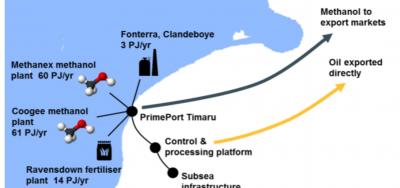Countries prosper when they play to their comparative advantages. In our case, natural gas is absolutely not one of them writes Rod Oram for Newsroom.
Yet, our gas sector keeps doubling down on its claims it can help us and other countries drastically cut carbon emissions in the decades ahead, while deriving great GDP benefits along the way. None of those claims stack up on economic or environmental grounds.
'We have the right geology', is the sector’s main claim. Seismic surveys of large areas of the deep oceans around New Zealand indicate the potential for enormous hydrocarbon reserves, it says.
Thus encouraged, the previous National government made oil and gas exploration one of its key economic development strategies. It went to great lengths to support exploration by international and local companies. Initially, that generated a substantial rise in activity. But many of the companies soon lost interest.
“[P]roduction has been in decline over the last seven‐to‐eight years with no substantial new discoveries. Oil and gas exploration has collapsed to $10 million in 2015 from $300 million in 2010 due to international market changes,” concludes the latest economic development strategy by Taranaki, the sector’s home.
Notably, Shell, the fourth-largest gas producer in the world, has quit New Zealand after selling its last gas assets here at a much lower price than it had hoped for. It says it is focusing on finding mega fields on and offshore in, or close to, existing production provinces of the world, thus ending its 100-year involvement here.
Even if our geology did hold a mega find, the cost of developing it would be prohibitive, particularly if it was in our deep and stormy Southern Ocean. It would have to compete against the glut of cheap gas in the world, while additional new low-cost, more easily accessible finds keep being identified abroad.
Our existing land and inshore fields produce expensive gas compared with the many other sources around the world, according to annual data compiled by our government. In 2016, our business users paid an average of US$26.60 per gigajoule, whereas Australia’s cost was US$15.60 and the US’s US$9.20.
We can help ourselves and help the world by playing to our comparative advantages in agriculture and renewable energy.
Moreover, given its vast reserves and fracking, the US is becoming a massive gas exporter, competing against long established Middle East and Asian suppliers. Likewise, Australia is on track by year-end to become the world’s largest exporter of liquefied natural gas, overtaking Qatar. These, and many other countries, have great competitive advantages over us in natural gas.
Thankfully, though, the un-bankability of our deep offshore geology has averted a potential ecological disaster. While the odds are long of an exploration or production well failing far out at sea, the sector here has never convincingly explained how it would cope if one did.
As the Deepwater Horizon disaster in the Gulf of Mexico proved in 2010, a massive and speedy response is vital. Most important of all was the quick drilling of relief wells to take the pressure off the failed well so it could be capped. Including the clean-up of the three-month oil spill, some 3,000 ships were involved.
Continue to the full article on Newsroom





